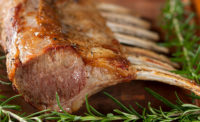The loss of the foodservice market because of the COVID-19 pandemic has been devastating to the American lamb industry. An estimated 40 to 50 percent of American lamb was marketed to dine-in restaurants as well as resorts, cruise ships and other foodservice operations. It is unknown when the foodservice market for lamb will return.
It is estimated the sheep and lamb industry will experience a 25 percent loss in consumer demand in 2020. This loss will translate into significant declines in slaughter and feeder lamb prices during the second, third and fourth quarters of 2020.
While lamb processors and distributors shifted product from foodservice to retail outlets, they could not make this shift as easily as other meat sectors. That’s because the cuts sold into foodservice were generally more expensive cuts from the loin or rack primals.
State of the Industry 2020
OverviewBeef (NCBA)
Beef (FQF)
Pork
Chicken
Turkey
Veal
Lamb
Seafood
Food Safety
Workforce
Sustainability
Packaging
Watch the 2020 State of the Industry Webinar
Register for free today!
According to a report from Information Resources Inc. (IRI), retail lamb volume sales increased 20.8 percent from March 15 to Aug. 9 versus the same time period a year ago. This translated to an additional 4.6 million pounds of lamb sold. Dollar sales of lamb during this period were up 30.5 percent as compared to the previous year according to IRI.
A recession is likely to prolong the affects of COVID-19 on the lamb industry as consumer demand for lamb is more price sensitive than other proteins.
The American Lamb Board responded to these unprecedented market shifts by focusing on retail promotions and new cookbooklets as well as social media and virtual events to educate consumers about how to cook lamb. Many consumers were trying lamb for the first time at home, and the American Lamb Board focused on supporting simple meal preparation with lamb.
A summer promotion with Texas grocery store chain H-E-B promoted the benefits of lamb through the H-E-B registered dieticians. The dieticians participated in a webinar and received coupons and information packets to promote lamb to their customers. An American Lamb Board recipe booklet and coupons also were offered to H-E-B customers.
A summer online #Glamburger consumer challenge encouraged consumers to try an American Lamb burger. Consumers had the options of firing up their grill and making their own burger or ordering from a local restaurant. To push out the news on this burger-themed challenge to consumers, the American Lamb Board promoted burger recipes, shared videos of how to create a delicious lamb burger and offered a free spice blend for those looking to spice-up their #Glamburger creation at home.
ANNUAL LAMB AND MUTTON FORECASTS
| 2016 | 2017 | 2018 | 2019 | 2020 | 2021 | |
| Production (million lb.) | 150 | 145 | 153 | 149 | 141 | 145 |
| Per capita disappearance (retail lb.)* | 1.0 | 1.1 | 1.1 | 1.1 | 1.1 | 1.1 |
| Lamb and mutton imports (million lb.) | 216 | 252 | 273 | 272 | 277 | 273 |
Forecasts are in bold. * Per capita meat and egg disappearance data are calculated using the Resident Population Plus Armed Forces Overseas series from the Census Bureau of the Department of Commerce. All data as of Sept 17, 2020. Source: World Agricultural Supply and Demand Estimates and Supporting Materials. For further information, contact: Mildred M. Haley, mhaley@ers.usda.gov
An Easy Entertaining cookbooklet included lamb recipes for celebrations — from cocktail parties to summer cookouts. A new American Lamb Comfort Classics cookbook offered ideas for comfort foods with a modern twist on traditional favorites including burgers, meatloaf and Cobb salad.
The American Lamb Board’s 11th annual Lamb Jam Tour went virtual for the more than 1,000 consumers who purchased tickets in advance. The virtual Lamb Jam @ Home included presentations from U.S. sheep producers, top chefs, butchers and beverage experts. Participants received a coupon to purchase lamb at their local grocery stores.
The American Lamb Board also teamed up with Taziki’s Mediterranean Café to promote char-grilled lamb dishes this fall, including its take-home Lamb Family Feast. The partnerships included in-store signage and promotions, recipe ideas and a social media campaign. Taziki’s has more than 90 restaurants in 17 states.
While hit by many factors of the pandemic, the American lamb industry is committed to telling its story and coming back strong in 2021. NP




Report Abusive Comment